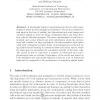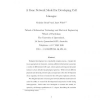246 search results - page 10 / 50 » Robot control with biological cells |
ICRA
2007
IEEE
14 years 1 months ago
2007
IEEE
— This paper presents a method for the control of locomotion in a robot hexapod. The approach is based on the WalkNet structure, which in turn is based on the neural control stru...
SASO
2008
IEEE
14 years 1 months ago
2008
IEEE
—High level languages greatly increase the power of a programmer at the cost of programs that consume more s than those written at a lower level of abstraction. This inefficienc...
MIRRORBOT
2005
Springer
14 years 27 days ago
2005
Springer
Abstract. A biologically inspired computational model of rodent representation–based (locale) navigation is presented. The model combines visual input in the form of realistic tw...
ECAL
2003
Springer
14 years 19 days ago
2003
Springer
Abstract. Whiskers are versatile sensors for short-range navigation and exploration that are widespread in many animal species, especially in rodents. Their arrangement is in very ...
ALIFE
2005
13 years 7 months ago
2005
Biological development is a remarkably complex process. A single cell, in an appropriate environment, contains sufficient information to generate a variety of differentiated cell ...


